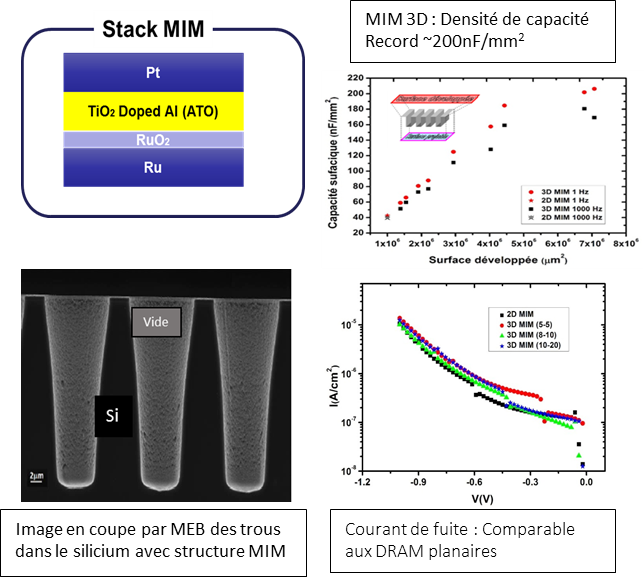- Share
- Share on Facebook
- Share on X
- Share on LinkedIn
The research work on MIM structures based on TiO2, called high-k, deposited by ALD aimed at (1) the study of the mechanisms of the chemical reactions which occur during the deposition of TiO2 on the surface of the conductive substrate of RuO2 and their consequences on obtaining the rutile phase, the most sought after
(2) the study of the feasibility of three-dimensional MIMs obtained by deposition on a substrate structured by etching, in order to achieve a capacitance density > 100nF/mm2 and
(3) carrying out measurements of dielectric losses at low, medium and high frequencies. On the first axis of the study, these physicochemical analyzes (RAMAN, XPS, HRTEM) showed that when H2O is used as oxidant, a layer of Ti2O3 is obtained during the first cycles of the ALD process, and the layer RuO2 is reduced to Ru following the “pumping” of oxygen by the titanium precursor. In this case, there is no possibility to re-oxidize the Ru surface to RuO2 due to the low oxidizing power of H2O. When oxygen plasma is used in the ALD process, RuO2 is also reduced to Ru again by pumping oxygen.

However, in this case the oxygen radicals have sufficient oxidizing power which leads to the re-oxidation of Ru into RuO2. Consequently, the RuO2 surface is regenerated, allowing the growth of a rutile TiO2 phase.
In the second axis of this study, an etching process was developed to obtain patterns with inclined sides, essential for depositing conformal MIM structures. The electrical characterization of these 3D MIM structures made it possible to note performances comparable to planar MIM structures, particularly in terms of leakage current, and that the capacitance per unit area was multiplied by a factor of 1.5 to 5. Thus, it has been shown the possibility of producing 3D MIM structures based on TiO2 which have a capacitance of up to 185 nF/mm2 [A. CHAKER et al., Applied Physics Letters, 110(24),243501 (2017)].
In the third axis, the dielectric response of MIM structures based on doped or undoped TiO2 in the frequency range from 1 Hz to 2 GHz was studied. In particular, we studied the effect of Al doping and thickness on the leakage current, AC conductance and loss tangent of the TiO2 layer. This study highlighted the potential interest of MIM capacitors with Al-doped TiO2 in the HF domain with a high dielectric constant throughout the frequency range and a low leakage current.
- Share
- Share on Facebook
- Share on X
- Share on LinkedIn